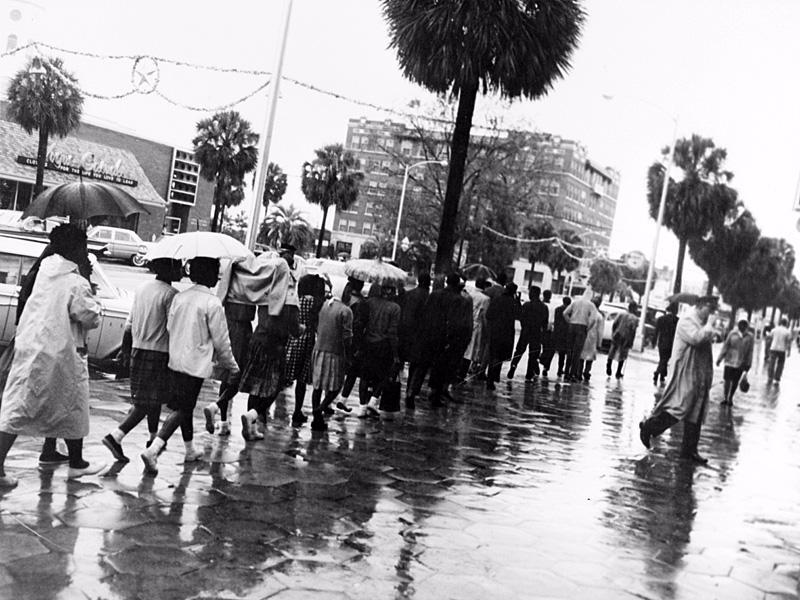Albany Movement Civil Rights Movement

Protesters on Broad Street, Albany, Georgia, ca. 1961
Courtesy Georgia Athenaeum (dgh231-86)
The Albany Motion was a desegregation campaign formed on Nov 17, 1961, in Albany, Georgia. Local activists from the Student Nonviolent Analogous Committee (SNCC), the National Association for the Advocacy of Colored People (NAACP), the Ministerial Alliance, the Federation of Woman's Clubs, and the Negro Voters League joined together to create the movement. The Albany Movement challenged all forms of racial segregation and bigotry in the city. Martin Luther King Jr. and the Southern Leadership Conference (SCLC) joined the motility in December 1961.
SNCC members Charles Sherrod and Cordell Reagon traveled to Albany in October 1961 to help organize the local black community. Although earlier protests had occurred, black residents were frustrated with the city committee's failure to address their grievances. Sherrod and Reagon organized workshops around irenic tactics for Albany's African American residents in anticipation of a showdown with the local police. On November 1, 1961, when the Interstate Commerce Commission (ICC) ban on racial segregation in interstate double-decker terminals went into effect, Sherrod and Reagon saw it as an opportunity to test segregation polices. They sent nine students from Albany State College to acquit a sit-in at the bus terminal. None of the students was arrested, but their actions inspired local blackness leaders to bring together the movement.
The Albany Motility intended to cease all forms of racial segregation in the city, merely it initially focused on desegregating travel facilities. Information technology also formed a biracial commission to discuss further desegregation and called for the release of those jailed in earlier segregation protests. Movement protestors used mass demonstrations, jail-ins, sit-ins, boycotts, and litigation. Although the first protestors were mostly students, the campaign eventually involved large numbers of black adults of varied class backgrounds.
Laurie Pritchett, who was the Albany police chief, responded to the protest demonstrations with mass arrests of the protesters. By December 1961, when more than five hundred protesters were jailed, William 1000. Anderson, the commencement president of the Albany Move, chosen on Dr. Martin Luther King Jr. to help reinvigorate the stalled campaign. Some SNCC members were concerned nearly King's interest, worrying publicly that his way of leadership would cause local blacks to abandon their own efforts against racism and exploitation, thinking that simply a prominent outside leader could save them.
Male monarch arrived in Albany on Dec 15, 1961, and spoke at a mass meeting at Shiloh Baptist Church. The following solar day, King, Anderson, and Ralph Abernathy—the SCLC's 2nd-in-command—joined hundreds of black citizens behind bars on charges of parading without a allow and obstructing the sidewalk. Despite SNCC's fears, King'due south involvement in the motion did attract national media attending, and it inspired more members of the black community to bring together the protests. Shortly afterwards Male monarch was arrested, city officials and Albany Movement leaders agreed that if King left Albany, the urban center would comply the ICC ruling and release jailed protesters on bond. Subsequently Rex left Albany, the city failed to uphold its understanding and protests continued into 1962.
On July 10, 1962, King and Abernathy were institute guilty of having paraded without a permit in December 1961 and were ordered to pay $178 or serve forty-v days in jail. They chose to stay in jail, hoping their imprisonment would again draw attention to the Albany Movement. On July 12, however, Chief Pritchett notified Male monarch and Abernathy that their bond had been paid by an unidentified black man, and they were immediately released. On July 27, 1962, King was arrested for a third time, just on Baronial 10, 1962, he agreed to leave Albany, catastrophe his involvement in the Albany Movement. Although SNCC connected its efforts in Albany, almost all of Albany'south public facilities remained segregated after King's departure.
Do you lot find this information helpful? A pocket-sized donation would help us keep this available to all. Forego a bottle of soda and donate its cost to us for the information you just learned, and experience expert most helping to get in bachelor to everyone.
BlackPast.org is a 501(c)(3) not-turn a profit and our EIN is 26-1625373. Your donation is fully tax-deductible.
Cite this article in APA format:
Momodu, S. (2016, Baronial 31). The Albany Movement (1961–1962). BlackPast.org. https://www.blackpast.org/african-american-history/albany-movement-1961-1962/
Source of the writer'south information:
"Albany Motion," Martin Luther King Jr. and The Global Freedom
Struggle,
http://kingencyclopedia.stanford.edu/encyclopedia/encyclopedia/enc_albany_movement/;
"Albany Movement" New Georgia Encyclopedia,
http://www.georgiaencyclopedia.org/articles/history-archaeology/albany-move;
"Albany Motion," The University of Georgia Freedom on Pic Civil
Rights in Georgia http://www.civilrights.uga.edu/bibliographies/albany/.
Albany Movement Civil Rights Movement,
Source: https://www.blackpast.org/african-american-history/albany-movement-1961-1962/
Posted by: davisonated.blogspot.com


0 Response to "Albany Movement Civil Rights Movement"
Post a Comment